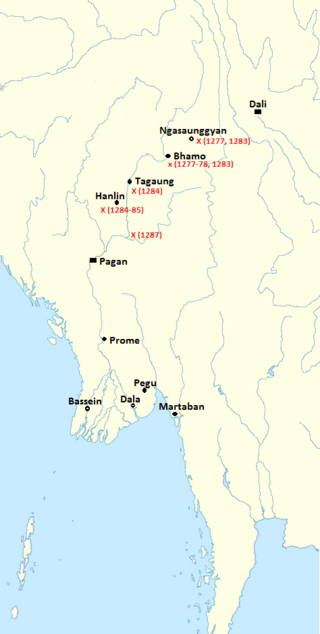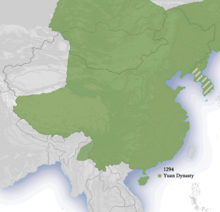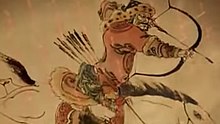
The 13th century was the century which lasted from January 1, 1201 through December 31, 1300 (MCCC) in accordance with the Julian calendar.
Hong Ta-gu was a Goryeo commander of the Yuan dynasty. His given name was Chun-gi, but he was more well known by his courtesy name Ta-gu. Born to a northwestern warlord family that defected to the Mongol Empire, Hong Ta-gu led Goryeo forces who had defected in campaigns against Goryeo and Japan. The Hong family dominated the Goryeo defector families in Liaoyang and Shenyang during the latter half of the 13th century.

Singhasari, also known as Tumapel, was a Javanese Hindu-Buddhist kingdom located in east Java between 1222 and 1292. The kingdom succeeded the Kingdom of Kediri as the dominant kingdom in eastern Java. The kingdom's name is cognate to the Singosari district of Malang Regency, located several kilometres north of Malang City.

Öljeyitü Khan, born Temür, also known by his temple name as the Emperor Chengzong of Yuan, was the second emperor of the Yuan dynasty of China, ruling from May 10, 1294 to February 10, 1307. Apart from Emperor of China, he is considered as the sixth Great Khan of the Mongol Empire, although it was only nominal due to the division of the empire. He was an able ruler of the Yuan dynasty, and his reign established the patterns of power for the next few decades.

Major military efforts were taken by Kublai Khan of the Yuan dynasty in 1274 and 1281 to conquer the Japanese archipelago after the submission of the Korean kingdom of Goryeo to vassaldom. Ultimately a failure, the invasion attempts are of macro-historical importance because they set a limit on Mongol expansion and rank as nation-defining events in the history of Japan. The invasions are referred to in many works of fiction and are the earliest events for which the word kamikaze is widely used, originating in reference to the two typhoons faced by the Yuan fleets.
The Battle of Ngasaunggyan was fought in 1277 between the Yuan dynasty of China and the Pagan Kingdom of Burma led by Narathihapate. The battle was initiated by Narathihapate, who invaded Yunnan, a province of the Yuan dynasty. Yuan defenders soundly defeated the Pagan forces.

The Mongol invasions and conquests took place during the 13th and 14th centuries, creating history's largest contiguous empire, the Mongol Empire (1206–1368), which by 1260 covered large parts of Eurasia. Historians regard the Mongol devastation as one of the deadliest episodes in history.

The Battle of Bạch Đằng was the last major engagement during Mongol campaigns against Dai Viet and Champa, one of the greatest victories in Vietnamese military history. It was a naval battle between Đại Việt, commanded by Commander-in-Chief Prince Trần Quốc Tuấn, and the invading army of the Yuan dynasty, commanded by Admirals Omar and Fan Yi on the Bạch Đằng River, which Prince Hưng Đạo perfectly staged an ambush that destroyed the Yuan fleet, capturing its general, ending Kublai’s intention to conquer Dai Viet and Champa. The battle took place at the Bạch Đằng River, near Ha Long Bay in present-day northern Vietnam. The battle was a tactical masterpiece of the same stature as a previous battle of Bạch Đằng that occurred in 938.

The Mongol conquest of China was a series of major military efforts by the Mongol Empire to conquer various empires ruling over China for 74 years (1205-1279). It spanned seven decades in the 13th century and involved the defeat of the Jin dynasty, Western Liao, Western Xia, Tibet, the Dali Kingdom, the Southern Song, and the Eastern Xia. The Mongol Empire under Genghis Khan started the conquest with small-scale raids into Western Xia in 1205 and 1207.

Four major military campaigns were launched by the Mongol Empire, and later the Yuan dynasty, against the kingdom of Đại Việt ruled by the Trần dynasty and the kingdom of Champa in 1258, 1282–1284, 1285, and 1287–88. The campaigns are treated by a number of scholars as a success due to the establishment of tributary relations with Đại Việt despite the Mongols suffering major military defeats. In contrast, modern Vietnamese historiography regards the war as a major victory against the foreign invaders.
Mongol invasion of East Asia may refer to:
Jaya Simhavarman III, Chế Mân (制旻), or Prince Harijit, son of King Indravarman V and Queen Gaurendraksmi, was a king of Champa during a time when the threat of the Mongols was imminent. He held the title the half-king/junior king (arddharāja) on behalf of his father.

Kublai Khan, also known by his temple name as the Emperor Shizu of Yuan and his regnal name Setsen Khan, was the founder and first emperor of the Yuan dynasty of the Mongol empire that included Mongol, Chinese and other races. Decades before Kublai announced the dynastic name "Great Yuan" in 1271, khagans of the "Great Mongol State" already started to use the Chinese title of Emperor practically in the Chinese language since the enthronement of Temüjin as "Genghis Emperor" in Spring 1206.}} of the Mongol Empire from 1260 to 1294, although after the division of the empire this was a nominal position. He proclaimed the dynastic name "Great Yuan" in 1271, and ruled Yuan China until his death in 1294.

The Mongol conquest of the Song dynasty or the Song-Yuan War beginning under Ögedei Khan and completed under Kublai Khan was the final step of the Mongol conquest of China. With the conquest the Mongols ruled all of the continental East Asia under the Yuan dynasty. It is also considered the Mongol Empire's last great military achievement.

This article discusses the political divisions and vassals of the Mongol Empire. Through invasions and conquests the Mongols established a vast empire that included many political divisions, vassals and tributary states. It was the largest contiguous land empire in history. However, after the death of Möngke Khan, the Toluid Civil War and subsequent wars had led to the fragmentation of the Mongol Empire. By 1294, the empire had fractured into four autonomous khanates, including the Golden Horde in the northwest, the Chagatai Khanate in the middle, the Ilkhanate in the southwest, and the Yuan dynasty in the east based in modern-day Beijing, although the Yuan emperors held the nominal title of Khagan of the empire.

The first Mongol invasions of Burma were a series of military conflicts between Kublai Khan's Yuan dynasty, a division of the Mongol Empire, and the Pagan Empire that took place between 1277 and 1287. The invasions toppled the 250-year-old Pagan Empire, and the Mongol army seized Pagan territories in present-day Dehong, Yunnan and northern Burma to Tagaung. The invasions ushered in 250 years of political fragmentation in Burma and the rise of ethnic Tai-Shan states throughout mainland Southeast Asia.
The division of the Mongol Empire began after Möngke Khan died in 1259 in the siege of Diaoyu Castle with no declared successor, precipitating infighting between members of the Tolui family line for the title of khagan that escalated into the Toluid Civil War. This civil war, along with the Berke–Hulagu war and the subsequent Kaidu–Kublai war, greatly weakened the authority of the great khan over the entirety of the Mongol Empire, and the empire fractured into four khanates: the Golden Horde in Eastern Europe, the Chagatai Khanate in Central Asia, the Ilkhanate in Southwest Asia, and the Yuan dynasty in East Asia based in modern-day Beijing – although the Yuan emperors held the nominal title of khagan of the empire.

Goryeo under Mongol rule refers to the rule of the Mongol Empire and the Mongol-led Yuan dynasty over the Korean Peninsula from about 1270 to 1356. After the Mongol invasions of Korea and the capitulation of the Korean Goryeo dynasty in the 13th century, Goryeo became a semi-autonomous vassal state and compulsory ally of the Yuan dynasty for about 80 years. It has been referred to as a "son-in-law kingdom in the Mongol Empire." The ruling line of Goryeo, the House of Wang, was permitted to rule Korea as a vassal of the Yuan, which established the Branch Secretariat for Eastern Campaigns in Korea as an extension of Mongol supervision and political power. Members of the Goryeo royal family were taken to Khanbaliq, and typically married to spouses from the Yuan imperial clan, the House of Borjigin. As a result, princes who became monarchs of Goryeo during this period were effectively imperial sons in-law (khuregen). Yuan overlordship ended in the 1350s when the Yuan dynasty itself started to crumble and King Gongmin of Goryeo began to push the Yuan garrisons back.

The Kaidu–Kublai war was a war between Kaidu and Kublai from 1268 to 1301. Kaidu was the leader of the House of Ögedei and the de facto khan of the Chagatai Khanate, while Kublai was the founder of the Yuan dynasty. The Kaidu–Kublai war followed the Toluid Civil War (1260–1264) and resulted in the permanent division of the Mongol Empire. By the time of Kublai's death in 1294, the Mongol Empire had fractured into four separate polities: the Golden Horde khanate in the northwest, the Chagatai Khanate in the middle, the Ilkhanate in the southwest, and the Yuan dynasty in the east based in modern-day Beijing. Although Temür later made peace with the three western khanates in 1304 after Kaidu's death, the four successor states of the Mongol Empire continued their own separate development and fell at different times.

The military of the Yuan dynasty (1271–1368) were the armed forces of the Yuan dynasty, a fragment of the Mongol Empire that Kublai Khan established as a Mongol-led dynasty of China. The forces of the Yuan were based on the troops that were loyal to Kublai after the Division of the Mongol Empire in 1260. Initially, this force was a Tamma, a frontier army drawn from all Mongol tribes for conquest of China, which had no central organisation but was rather a loose collection of local warlords and Mongol princely armies. However, the army was gradually reformed by Kublai Khan into a more systematic force.
















